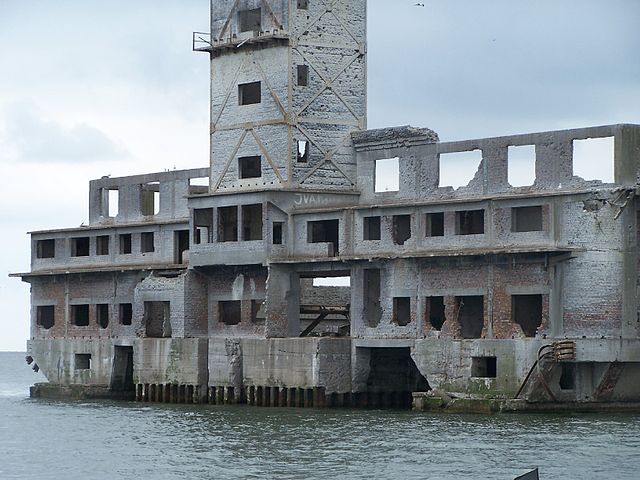Located 1,000 feet off the coast of Gdynia, Poland sits the former torpedo testing complex of Torpedownia. Known to the Germany military as Torpedowaffenplatz Hexengrund, it was used by the Kriegsmarine and Luftwaffe during World War II. It was occupied by Soviet forces following the conflict, and today sits abandoned, waiting to collapse into the water below.
Germany looks to develop its own torpedoes
The German Army invaded Poland in September 1939, signaling the start of the Second World War. At that point, the country’s military forces had been using torpedoes imported from Italy and Japan, and officials were looking to develop their own designs. This prompted the construction of a torpedo testing facility in the Bay of Puck, a western branch of the Bay of Gdańsk in the southern Baltic Sea.



Two different platforms were constructed. The most well-known was Torpedowaffenplatz Hexengrund – “Torpedownia” to the Polish. The other, Torpedo Versuchsanstalt Oxhôlt, better known as “Formoza,” was located just 4-5 KM away. Each ran independent of each other, with shared use of a training ground, and they were connected by a railway that ran along the beach.


Formoza was used by the Kriegsmarine, while Torpedownia was primarily used by the Luftwaffe. The latter featured a torpedo assembly hall, an observation and fire control tower, and two torpedo shafts from which the torpedoes were launched for testing. There was also a pier that connected the platform to the shore.
Testing torpedoes during the latter years of the war
The Luftwaffe tested aerial torpedoes at Torpedownia, which could be dropped from Junkers Ju 52, Heinkel He 111 and Focke-Wulf Fw 190 aircraft. The German model, the F5b, was in service from the latter part of 1941 until the end of the conflict, and used a wooden K3 tail to control its trajectory while in flight.
They could also be launched from E-boats, a fast attack craft used by the Kriegsmarine.



These torpedoes were assembled from parts brought in from the mainland by train. During the testing phase, they were launched without explosives and caught in a net that had been strategically placed between both Torpedownia and Formoza.
Soviet occupation of Torpedownia
With the Red Army rapidly advancing toward the area in March-April 1945, the German forces abandoned Torpedownia and Formoza, leaving them to fall under Soviet control. The Soviets disassembled the facilities’ technical equipment and sent them back to the USSR, where it’s believed they were never reassembled or used.


While stationed on Torpedownia and Formoza, the Soviets conducted military dive training and research. To prevent unwanted visitors from crossing the bay to Torpedownia, the wooden pier was blown up, with the remainder of its structure completely demolished in the 1990s. Presently, only the pier’s foundation is still standing.
Torpedownia and Formoza have since been abandoned
Today, Formoza is frequently used by the Polish military to conduct training for its special forces divers, who have been named after the abandoned German facility (full name Jednostka Wojskowa Formoza). The special forces’ headquarters is located in Gdynia.



More from us: The Hanging Coffins of Sagada: A Dying Burial Practice Steeped in History
For the most part, Torpedownia has been largely left abandoned. While it still stands and can be visited by both swimmers and those traveling by boat, it is at risk of collapsing. As such, visitors are told to exercise caution while exploring the platform.
